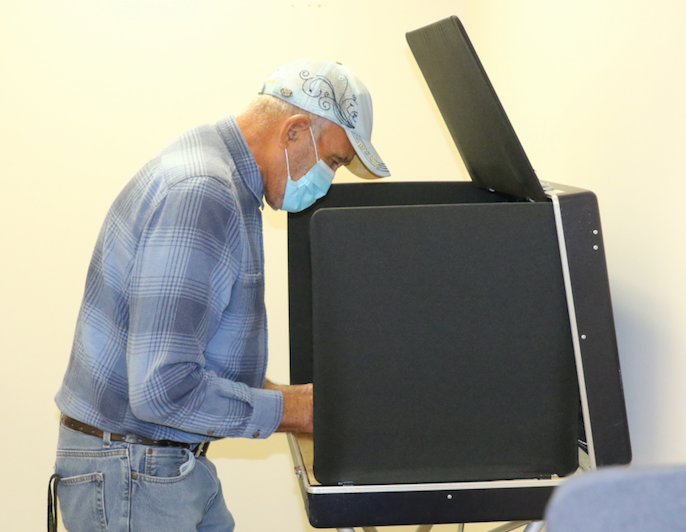PE Lunch Prices To Rise 10 Cents
Published 3:33 pm Tuesday, July 5, 2011
PRINCE EDWARD – On second thought, school lunches won't increase as much as expected.
County school board members at their June meeting again discussed the need to increase meal prices for the coming school year, but rather than 25 cents, they opted for a ten-cent hike.
“We had talked in terms last month of a 25-cent increase and we've backed off of that to suggest a 10-cent increase,” Division Superintendent Dr. David Smith said.
Supervisor of Food Service Bruce Davis explained at the May school board meeting that the Federal Health and Hunger-Free Kids Act of 2010 has a section that requires school food authorities participating in National School Lunch program to ensure that the schools provide the same level of support for lunches served to paying students as well as eligible free and reduced lunch students.
Prince Edward currently charges $1.75 for student lunches and even with the added 25 cents, it's still below the reimbursement rate (valued at $2.46). The minimum increase they could have, it was cited, is five cents.
While the school system is getting reimbursed the cost for free and reduced lunches (which cover the cost for preparing the food), they are losing money feeding the full-price student, Davis cited at the May meeting. The free and reduced rate, however, is currently high in the system which helps; Davis noted that if they didn't have that, then they would be losing money if they had more students paying full price.
Instead of having a potential big jump in prices, school officials were considering a more gradual increase starting with the 25 cents next year.
And though it will be less than initially thought for the coming year, lunch prices could also rise in coming years.
“…We also understand that over the next several years there will be more definition of how this needs to be increased incrementally,” Dr. Smith said. “So that we know that this is a first step in the increases.”
The increase would mean lunches would cost $1.85 per day per child.
“…Since this can be done gradually…you're looking at an economy and people that have more than one child in school and ten-cent doesn't seem like much,” school board member Harriett Fentress commented. “But with the way things are going and if you have more than one child in school it can impact. And it says that we can do it gradually…so can it be less than ten cent?”
Ms. Fentress reflected on an example where someone has three or four children in school, looking at it per lunch, per week, and per month, and noted that it will impact.
“You're exactly right on that,” Dr. Smith commented. “That's part of what drove our decision to recommend a lower increase, but the thing that we want to not lose sight of is the fact that the increase…is required over time and if we delay that, if we don't take incremental steps, then we run the risk of next year, the year after having to make a huge jump that has a very sudden impact on families just exactly for the reasons you gave.”
School board members, with Ms. Fentress opposed, approved the superintendent's recommendation for the 10-cent increase.
School officials were presented a phase-in plan that would reduce the number of credits required to graduate with a standard or advanced diploma.
The school's Internal Lead Partner Michelle Hairston detailed that Prince Edward has 28 credits for a standard diploma, 30 for an advanced diploma. Virginia is transitioning to 22 for a standard diploma; 26 for an advanced studies diploma.
Specifically, the phase-in plan looks first to incoming freshmen and new state requirements, but more changes could be coming for other classes.
“…As we look and continue to move forward,” Ms. Hairston said, “we may have to go to the state department (of education)-because one of the things we were looking at is to ensure that we meet the target of (an) 85 percent graduation rate. And, we…want to ensure that no student is dropping out and more students are graduating. So, as we begin to move forward, we may need to come to the State Department of Education to do some sort of recommending to amend our current practices to see if we could actually benefit from phasing in and transitioning, not just our freshman class, but looking at our rising seniors, our rising juniors, our rising sophomores.”
Dr. Smith added that they might want to make a request to the State Board of Education to possibly allow a waiver that might allow some interim transition consideration.
Still, he assessed, the first step is to align with the new state graduation requirements-22 and 26 credits-for Prince Edward.
“That's the first step that needs to be taken and that could be voted on in July if you would like to,” Dr. Smith said. “As long as it's done prior to the start of the school year.”
The Superintendent also cited that they know with their current high graduation requirements they far exceed the state and that they are “encouraging a much higher dropout rate and that doesn't seem fair to our students.”
Add to the mix that school officials are looking at changes to their master schedule moving from eight to a seven-class day-which would mean lowering the overall courses a student could take and could have implications for staff.
School board member Dr. Ellery Sedgwick offered that he very much understands that there is a problem, but that they need some time to gather the facts and understand why going to the state's minimum would be the best course and to understand what the impact on the staff is going to be before they vote.
They can go somewhere in between the requirements, Dr. Smith said, but for students transferring in or out it creates a potential hardship. (One possible option discussed is that students transferring in would be held to the requirements of the school they transferred from. It would have to be developed in Prince Edward's policy.)
It was also noted that lowering the requirements could make an advanced diploma more obtainable.
The issue was presented as a non-action item.
The board approved a new attendance policy discussed at their May meeting. Among the provisions outlined:
*When a student accumulates more than six unexcused absences in an academic year, the director of support services is to enforce the provisions of state code by either filing a complaint with the J&DR court alleging the pupil is a child in need of supervision or instituting proceedings against a parent for contributing to the delinquency of a minor
*It defines excused absences with definitions for illness, chronic/extended illness (where the parent must complete a notification form) pre-arranged appointments, family death or emergency, religious observances, and exceptional circumstances (outlining conditions).
*The policy outlines procedures for unexcused absences: when a student fails to report for a total of three unexcused days, a letter is to be sent to the parent/guardian explaining the consequences; when a child fails to report for five unexcused days, a parent conference is to be held to discuss the accrued absences and an attendance contract is to be developed with the student and parent; the sixth unexcused absence, an attendance support team is to convene to develop a plan of action and a referral made to the director of support services to enforce the provisions of law.
*It cites that, for the purpose of determining perfect attendance, a student must be present for two hours to be counted as present (although pre-arranged absences for religious observance is not counted against perfect attendance).
*Students, upon the return to school, will have five school days to make up their work, although additional time may be granted by the principal due to extenuating circumstances.
School officials looking to address consistency, were presented a plan as a non-action item that to realign the grading scale for grades one through four and reflect the same scale used at the middle school. The scale, which still needs school board approval, would register an “A” for grades 95-100, “B+” 92-94, “B” 87-91, “C+” 84-86, “C” 79-83, “D+” 76-78, “D” 71-75, and an “F” 70 and below.
School board member Thomas Tillerson registered some concerns-assessing that the scale for first graders is steep. Some students come with advanced skills and they do well; but they have many students in many areas that don't have the skills. Tillerson reflected on a child receiving a grade of 70 and getting an “F”. He would also offer that they don't want to defeat them at an early age.
It was noted that the first grade has been using number grades and is not a change for them. The change would make it consistent all the way up through middle school.
Pre-kindergarten and kindergarten would use “S” for satisfactory, “N” for needs improvement and “U” for unsatisfactory scale.
In other grading news, school board members were also presented as an information item a proposal that would bring consistency to course grading. Specifically, the proposal would outline that tests/projects, would count 30 percent; quizzes, 25 percent; class work, 20 percent; homework, 15 percent; and participation, 10 percent.
“…What we found at both the elementary and middle school was that there was-in many cases-a teacher discretion in terms of what the weighting was for different assignments,” Executive Director of Curriculum and Instruction Laura Williamson said. “So, again, both at the elementary and middle school, the school improvement teams discussed grading, the purposes of grades, how grades are communicated, what types of assignments are graded and how important the weighing is of different types of assignments. And they also came up with a consistency…so that teachers across grades, across subjects and across schools will be using the same weighting for assignments.”
She offered that it's a “very significant improvement.”
School board members were also presented updated report cards for pre-kindergarten and kindergarten as a non-action item.
*The school board, with much discussion and some wording changes, approved the student code of conduct for the high school.
*School board members were presented, and approved, a five-year technology plan that outlines goals, objectives and strategies. They followed the guidelines from the Virginia Department of Education, according to Director of Accountability and Research Dr. Roy Echeverria.
Having made investments in physical infrastructure in about the last year and a half, Dr. Echeverria assessed that it would not require the investment it required in that timeframe.
*The board agreed to schedule a surplus auction for 9 a.m. Saturday, July 9.
*Dr. Echeverria reported that they have given 90 computers (taken out of service) to students. The limiting factor, he cited, is the speed with which students can refurbish the computers. (Students eligible to receive the computers are essentially selected by lottery.)
There are about six students refurbishing the computers and Dr. Smith noted that it is not realistic to expect this to dominate their year of instruction. He assessed it's a great idea where it fits with their curriculum and gives them experience but also suggested that they designate a low, reasonable number and to dispose of the remaining computers.
The board agreed to target 40 units to give away next year, authorized the retention of parts computers thought to be necessary, and to dispose of the rest. (It was estimated that they had about 275 computers at various stages of repair or disrepair.)
*Supervisors, approved a resolution calling for regulatory relief from the Elementary and Secondary Education Act.
Dove noted that overall, he supports No Child Left Behind-noting that some of the intentions are “admirable.” However, he added that some of the provisions are unrealistic, especially as it relates too AYP and special education.
“…It doesn't seek to undermine the whole concept of accountability and…high standards, it simply asks for some relief,” Dr. Smith said.
*The board agreed to schedule a retreat for August 27.
*School board members were presented with a lengthy list of school board policy updates based on changes in law and regulations to consider on first reading. No action was taken.
*It was reported that 22 in-door cameras had been installed at the middle school focusing on the gym, hallways, locker areas and in the cafeteria, as well as six additional cameras in the career technical center to cover blind spots.
*It was cited that the middle school has been selected to provide a presentation on Eagle Watch, a student-educator mentoring program, at the VSBA's Governor's Conference on Education later this month.
*Out-of-county residents educating their children in Prince Edward may soon expect to pay a little more. The board was presented the matter as a non-action item. (Tuition rates are based on the level of funding received from the County.) County funding increased 2.45 percent for the coming school year, increasing the non-resident fee by $58.
This past year, it was cited, there were seven non-resident students.
School board recognitions included:
*Breanna Smalley, who won ACHIEVE 3000 Contest, A Story in Every Town! Smalley's article was chosen over other entries from seventh graders nationwide; she won an iPod shuffle.
*Gabriel Dudley's poem received second place at the state competition of the women's club literary contest.
*Creative writing competition winners were recognized including Calla Bowles, first place for an essay in a Daughter of the American Revolution contest.
Several students were selected to read their poems at the Longwood Center for the Visual Arts including Calla Bowles, Kyle Hart, Amber Harvin, Shayna King and Jasmin Vaughan.
Southside Electric Cooperative writing competition winners included Da'Quan Johnson, Kyle Hart and Kaliena Dimaano, who received first place (all-expense paid trip to Washington D.C. for one week); Jennifer Thompson, Jasmin Vaughan and Jessica White runners up ($100 for each of the three).
*Women's Club writing winners at the local level were recognized including Calla Bowles, Emily Ironmonger, Carter Chassey, and Alice Adkins; District level writing winners included Calla Bowles, Alice Adkins and Emily Ironmonger.
*The board recognized Kacey Potter as the division's Teacher of the Year.




